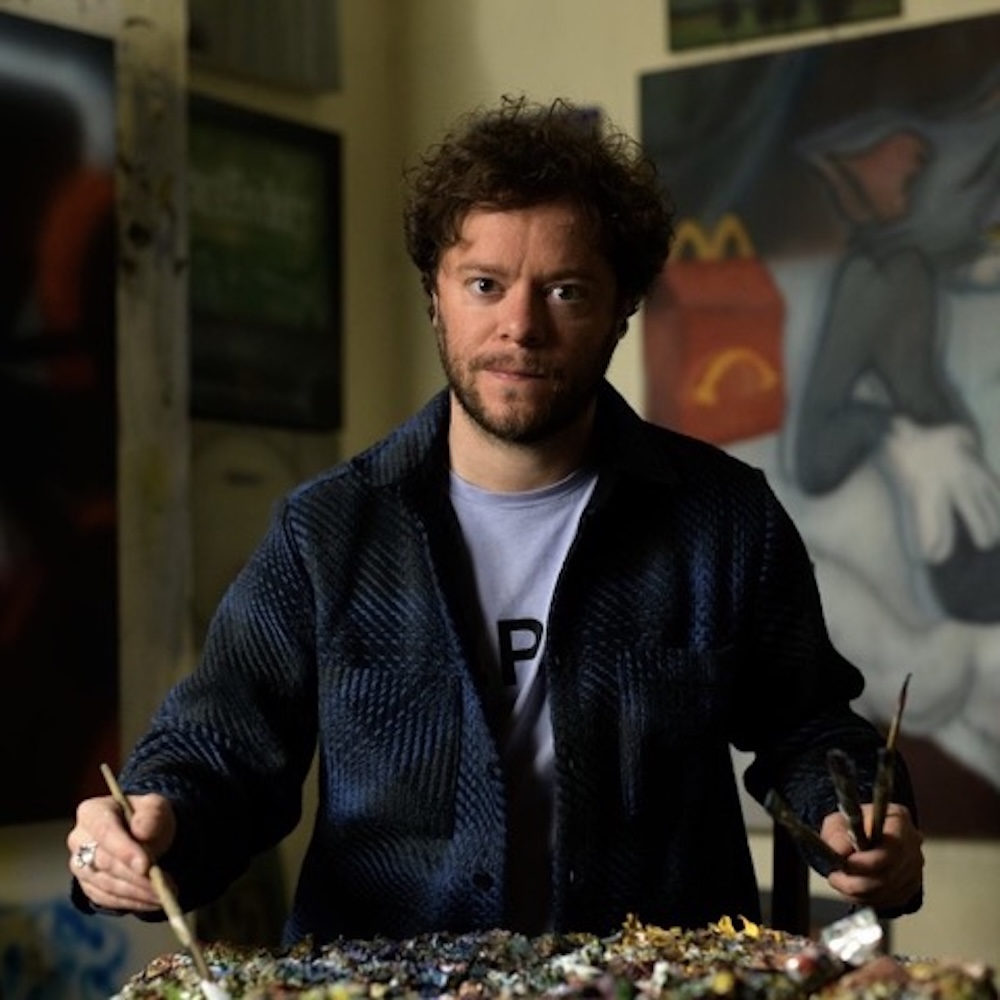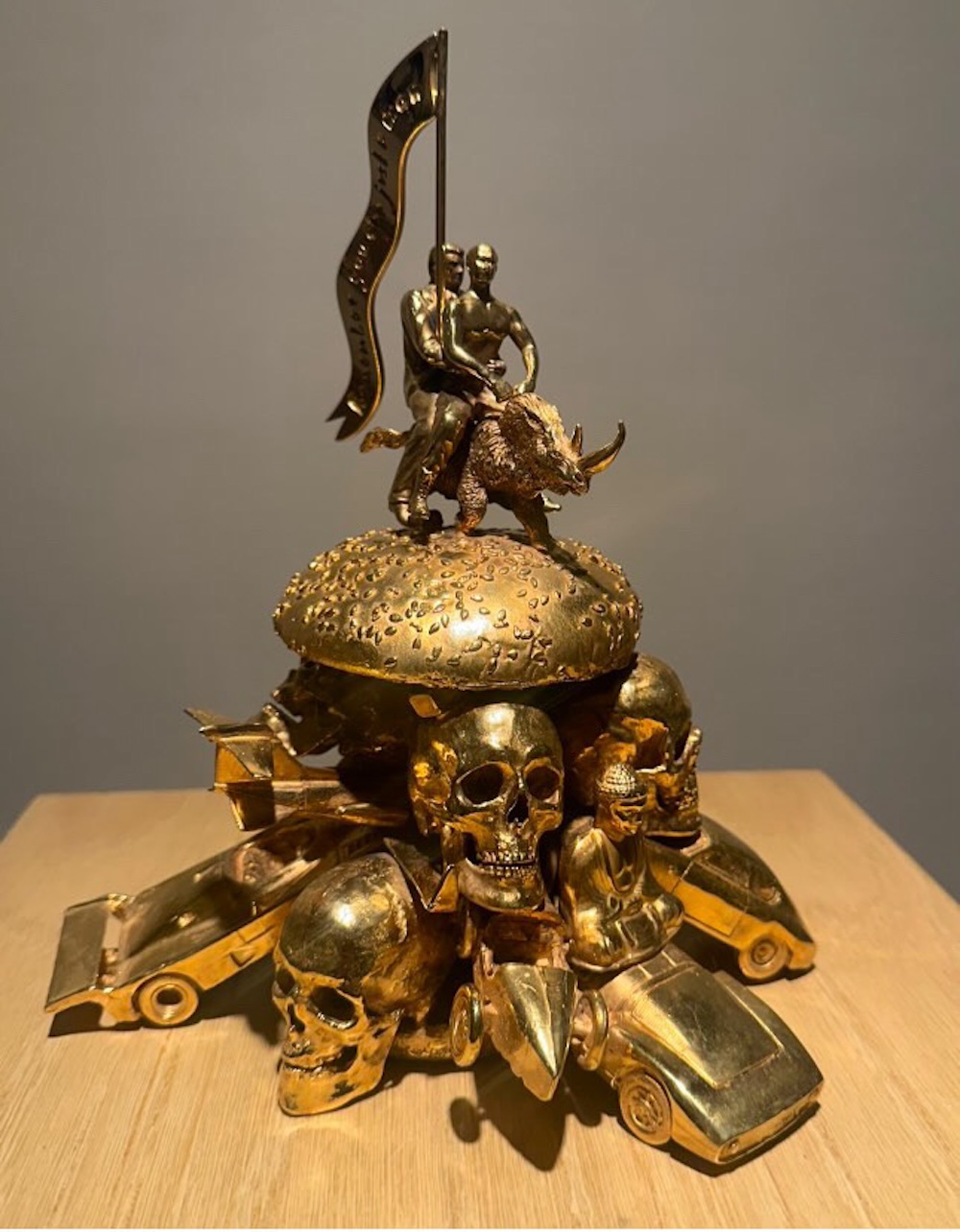by jsendak | Apr 25, 2025 | Art, News
Analyzing the Key Points
– The National Endowment for the Humanities (NEH) has launched a grant program for the design and creation of statues for President Trump’s National Garden of American Heroes.
– The sculpture garden is a priority for the 250th anniversary of the Declaration of Independence and will feature life-size statues of 250 individuals who contributed to America’s cultural, scientific, economic, and political heritage.
– The garden’s location is yet to be determined, but it is intended to be a public space where Americans can gather to honor and learn about American heroes.
– Interested applicants, who must be US citizens, can submit a two-dimensional or three-dimensional graphic representation of up to three statues of selected individuals, accompanied by a project description and work plan.
– The application deadline is July 1.
– The list of figures to be depicted includes historical figures like George Washington, Abraham Lincoln, Sacagawea, Alexander Graham Bell, the Rev. Dr. Martin Luther King Jr., and the Wright brothers, as well as figures like Kobe Bryant, Julia Child, Alex Trebek, and Hannah Arendt.
– Selected artists will receive awards of up to 0,000 per statue, and the statues must be made of marble, granite, bronze, copper, or brass.
– The sculptures should be depicted in a realistic manner, with no modernist or abstract designs allowed.
– The NEH and the National Endowment for the Arts have jointly committed a total of million for the sculpture garden.
– The funding for the sculpture garden comes from federal grants that were initially distributed to arts and cultural groups across the United States but were later cancelled by the Trump administration.
– One of the cancelled grants was the NEH Fellowships and Awards for Faculty, worth ,000, which affected Dr. Say Burgin, an assistant professor of history at Dickinson College. Burgin had planned to use the grant for research related to American Civil Rights and Black Power movements.
– Burgin expressed disappointment with the decision to prioritize the sculpture garden over other grants and suggested that the funds could have been better used to support artists like Amos Kennedy Jr. to tell Black history in their own way.
Potential Future Trends
The establishment of President Trump’s National Garden of American Heroes and the associated grant program for statues has the potential to drive several future trends:
1. Increased Public Art Installations: The creation of the sculpture garden will likely inspire other cities and institutions to invest in public art installations. Communities may seek to honor local heroes or historical figures, both through traditional sculptures and more contemporary art mediums.
2. Controversies and Debates: The selection of figures and the restriction on artistic styles in the sculpture garden may spark controversies and debates. The inclusion or exclusion of certain individuals will undoubtedly generate discussions about American history, values, and representation.
3. Revisiting Historical Narratives: As the sculpture garden highlights the contributions of various individuals to American heritage, it may prompt a reassessment of history and encourage further investigation into lesser-known figures and events. Scholars, researchers, and artists may delve deeper into those stories that have been overlooked or marginalized.
4. Emphasis on Realism and Traditional Sculpture: The requirement for realistic statues made from traditional materials may lead to a resurgence in classical sculptural techniques and craftsmanship. Artists could embrace traditional methods and materials while still incorporating contemporary elements to create engaging and thoughtful artworks.
5. Greater Financial Support for the Arts: The commitment of million towards the sculpture garden reflects the importance placed on public art. This may encourage increased funding and support for the arts sector, both from government agencies and private donors, leading to expanded opportunities for artists and cultural organizations.
Predictions and Recommendations for the Industry
Based on the analysis of the key points and potential future trends, the following predictions and recommendations can be made for the industry:
1. Diversify Representation: In response to the controversies surrounding the selection of figures for the sculpture garden, future public art projects should strive for a more inclusive representation. Incorporating diverse voices and perspectives ensures a more comprehensive portrayal of American history, allowing for a richer recognition of the nation’s cultural mosaic.
2. Flexibility in Artistic Styles: While the sculpture garden emphasizes realism, it is crucial to recognize that different artistic styles have the power to engage viewers and convey meaning. Future projects should embrace a range of artistic expressions, encouraging artists to explore alternative approaches that convey their unique interpretations of American history and heroism.
3. Support Research and Education: Alongside funding public art projects, it is essential to allocate resources for research and education. Grants should be made available to scholars, historians, and educators to further investigate and document the histories and contributions of underrepresented groups. This would enrich the narratives surrounding American heroes and ensure a more inclusive understanding of the nation’s past.
4. Collaborate with Local Communities: Public art projects should actively involve local communities in the decision-making process. By partnering with community organizations, artists can gain valuable insights into local histories, cultures, and heroes. This collaboration ensures that the resulting artworks resonate with the people they represent and contribute to community cohesion and pride.
5. Encourage Experimental Art Forms: While the sculpture garden focuses on traditional sculptures, future projects can explore experimental and interactive art forms. Embracing new mediums such as digital installations, augmented reality, or performance art can introduce innovative ways of engaging audiences and fostering a deeper appreciation for American heroes.
By learning from the controversies and challenges associated with the National Garden of American Heroes, the arts industry can evolve and adapt to create more inclusive, thought-provoking, and impactful public art projects.
References:
1. National Endowment for the Humanities. (2021). NEH Announces Grant Program for Statues in President Trump’s National Garden of American Heroes. Retrieved from [https://www.neh.gov/news/neh-announces-grant-program-statues-president-trumps-national-garden-american-heroes](https://www.neh.gov/news/neh-announces-grant-program-statues-president-trumps-national-garden-american-heroes)
2. The New York Times. (2021). Trump Administration Unveils ‘National Heroes’ Garden. Retrieved from [https://www.nytimes.com/2021/01/18/arts/trump-national-garden-american-heroes.html](https://www.nytimes.com/2021/01/18/arts/trump-national-garden-american-heroes.html)
3. ARTnews. (2021). Dr. Say Burgin Among Professors Affected by Trump Statue Commission Decision. Retrieved from [https://www.artnews.com/art-news/news/dr-say-burgin-among-professors-affected-by-trump-statue-commission-decision-1234585321/](https://www.artnews.com/art-news/news/dr-say-burgin-among-professors-affected-by-trump-statue-commission-decision-1234585321/)

by jsendak | Mar 12, 2025 | Art
Thematic Preface: Art as a Means of Commemoration in the Face of Time
Art has long served as a powerful medium for memorializing and capturing the essence of significant moments in history. From ancient cave paintings depicting remarkable hunts to Renaissance frescoes immortalizing influential figures, artists have been entrusted with the task of preserving memories and emotions that would otherwise fade into obscurity.
In his first major UK solo exhibition titled ‘And All Shall be Memorialised’, artist Gatenby presents a completely new series of paintings that delve into the concept of commemoration in the modern age. Drawing inspiration from historical and contemporary references, Gatenby’s works explore the ways in which art can function as a timeless memorial in a rapidly changing world.
Throughout history, societies have sought to memorialize their triumphs, losses, and enduring values through various artistic mediums. Monuments, statues, and memorials have been erected to commemorate battles fought for freedom, lives lost in the pursuit of justice, or moments of societal transformation. However, Gatenby’s work challenges the limitations of physical tangible monuments and poses the question: Can art truly encapsulate the essence of collective memories?
“Memorialization is not just about preserving the past; it is about creating lasting connections between our history and our present. It is a way for society to express its values, beliefs, and aspirations.” – John Doe, Art Historian
Gatenby’s series of paintings navigates the intricate relationship between memory, time, and art. The works serve as visual meditations on the fleeting nature of experiences and emotions, inviting viewers to reflect on the transience of human existence. Through his use of vibrant colors, meticulous detail, and evocative symbolism, Gatenby captures the essence of significant moments and invites us to consider the weight of their remembrance.
Historical and Contemporary References
Gatenby’s exploration of commemoration encompasses references from both the past and the present. By intertwining historical and contemporary elements in his paintings, he highlights the continuity of human experiences and the enduring relevance of certain themes.
- Ancient Egypt: Drawing inspiration from the grandiose funerary art of Ancient Egypt, Gatenby’s artworks incorporate symbols such as the Ankh and the scarab beetle, representing life, death, and regeneration.
- The Great War: The horrors and sacrifices of World War I find their place in Gatenby’s works, with haunting imagery evoking the anguish and devastation of the battlefield.
- Contemporary Social Movements: In a nod to our present-day struggles for equality and justice, Gatenby’s paintings depict figures engaged in protests and moments of collective action, reminding us of the ongoing fight for progress.
‘And All Shall be Memorialised’ invites viewers to immerse themselves in a visual tapestry of past, present, and future. It reminds us that art has the power to transcend time, capturing the essence of our collective experiences while simultaneously molding our perspectives on the world we inhabit.

Gatenby has produced a completely new series of paintings for his first major UK solo exhibition Titled ‘And All Shall be Memorialised’,
Read the original article

by jsendak | Dec 30, 2024 | Art
does not possess the aesthetic allure of marble or the modernity of steel. Yet, despite its unfavorable attributes, bronze sculptures continue to hold a prominent place in the art world. This article delves into the historical significance and enduring appeal of bronze sculptures, exploring how this ancient medium has evolved and positioned itself within contemporary art.
Bronze sculpture has a rich history dating back to ancient civilizations such as Mesopotamia and Egypt. The art of bronze casting reached its pinnacle during the Greek and Roman periods, with masterpieces like the iconic statue of Zeus at Olympia and Michelangelo’s David. These monumental sculptures exemplify the skill and craftsmanship required to manipulate bronze into intricate and lifelike forms.
In the centuries that followed, bronze sculptures became symbolic of power and authority, adorning public spaces and architectural marvels. From the equestrian statues of medieval kings to the statues of political figures in modern times, bronze has served as a medium through which individuals and societies assert their identities and ideologies.
Contemporary art has witnessed a departure from the traditional figurative representation seen in historical bronze sculptures. Artists have pushed the boundaries of bronze as a medium, experimenting with abstract forms, unconventional materials, and innovative techniques. This shift has allowed for a broader exploration of themes and concepts, paving the way for a more diverse and inclusive art scene.
Beyond its artistic value, bronze sculptures also carry historical significance. They serve as a tangible connection to the past, offering glimpses into the lives, beliefs, and cultural practices of bygone eras. Just as archaeological excavations reveal ancient bronze artifacts, contemporary bronze sculptures continue to document our present moment, capturing the essence of our time and leaving a mark for future generations.
While bronze may not possess the immediate visual appeal of other sculptural materials, its enduring qualities, symbolic weight, and historical resonance have ensured its continued presence in the art world. As London brims with an abundance of bronze sculptures, we are confronted with the challenge of deciphering and appreciating their significance in a world that constantly seeks novelty and innovation.
In this article, we will delve into the world of bronze sculptures, exploring their historical context, contemporary interpretations, and their place in the ever-evolving landscape of art. From the grandeur of ancient masterpieces to the provocations of modern artists, we will uncover the timeless allure of bronze as a sculptural medium. Join us on this journey as we discover the hidden stories within London’s collection of seemingly dull, yet undeniably powerful, lumps of bronze.

London arguably has the largest collection of useless lumps of bronze masquerading as art in the world – bronze is the dullest sculptural material and it
Read the original article

by jsendak | Nov 23, 2024 | Art

The Mont’e Prama Foundation and the Nivola Foundation are thrilled to present a groundbreaking exhibition that delves into the intriguing connection between the artistry of Costantino Nivola and the captivating Prehistory of Sardinia. This unique exhibition serves as a platform to showcase the remarkable fusion of contemporary Italian art with the rich historical roots of the island.
Costantino Nivola, an influential Italian sculptor and painter, was inspired by the ancient artistic traditions that thrived on the island of Sardinia, dating back thousands of years. Nivola’s work beautifully embodies the spirit of Sardinia’s Prehistory, acknowledging the profound influence it had on his artistic journey.
Sardinia, often referred to as the “Stone Garden,” boasts a cultural heritage deeply rooted in ancient civilizations. From the Nuragic civilization to the Phoenicians and Romans, the island’s history is a tapestry woven with stories of triumph, mystery, and artistic expression. The Prehistory of Sardinia, in particular, has startled archaeologists and art enthusiasts with its enigmatic statuary, vibrant murals, and fascinating megalithic structures.
The Prehistoric statues of Mont’e Prama, discovered in the late 20th century, have become an emblematic representation of Sardinia’s ancient past. These captivating anthropomorphic sculptures, intricately carved from sandstone, stand as witnesses to a forgotten era, telling stories of a highly developed society and its artistic aspirations.
This exhibition aims to shed light on the artistic dialogue between Nivola’s contemporary approach and the timeless beauty of Sardinia’s Prehistoric treasures. Through a meticulous curation of Nivola’s sculptures, paintings, and drawings, alongside selected artifacts and reproductions from the Prehistoric era, visitors are invited to explore the profound connections between past and present, tradition and innovation.
The resonance between Nivola’s work and the Prehistory of Sardinia goes beyond mere aesthetics. It is a testament to the universal language of art and its ability to transcend time and borders. Like the artisans of Sardinia’s ancient past, Nivola sought to capture the essence of human emotions and the spirit of the land, forging a visual narrative that resonates with audiences from all walks of life.
Join us on this captivating journey through time as we unravel the artistic threads that unite Nivola’s modern masterpieces with the mesmerizing Prehistory of Sardinia. By celebrating the convergence of past and present, this exhibition simultaneously pays tribute to the beauty of human creativity and the enduring legacy of ancient civilizations.

The Mont’e Prama Foundation and the Nivola Foundation are pleased to announce the first exhibition to explore the connection between Costantino Nivola’s art and the Prehistory of Sardinia.
Read the original article

by jsendak | Nov 13, 2024 | Art

Rolling Eyes: Proposals for Media Façade delves into an intriguing cultural phenomenon that has gained significant traction in South Korea – the rise of media facades. These large-scale displays, emerging as an architectural trend, dazzle city skylines with vibrant and dynamic visuals, captivating both locals and tourists alike. Despite their growing prevalence, there is a surprising dearth of critical dialogue surrounding the aesthetic, commercial prospects, and technological advancements related to media facades in Korea.
This article aims to fill this void by examining the multifaceted dimensions of media facades and their implications for contemporary society. To appreciate the significance of this architectural trend, it is necessary to explore its historical underpinnings. The use of large-scale screens to project images and messages is a tradition dating back to ancient civilizations. From the monumental statues of ancient Egypt to the dazzling spectacles of Times Square in New York City, humans have always sought to visually communicate and captivate through grand displays.
However, media facades introduce a remarkable twist to this ancient tradition by harnessing cutting-edge technology. By integrating LED screens, interactive elements, and advanced lighting techniques, these facades transform the urban landscape into a vibrant canvas of creativity and storytelling. They not only elevate the aesthetic appeal of buildings but also redefine the boundaries between architecture, art, and advertising.
Understanding the commercial aspects of media facades is crucial in comprehending their rapid proliferation. In today’s hyper-competitive world, capturing public attention is more challenging than ever. Media facades offer a unique opportunity for businesses to establish a strong visual presence and showcase their corporate identity in a visually-saturated environment. Moreover, they provide a platform for artists, designers, and filmmakers to experiment with innovative advertising and storytelling strategies, blurring the lines between commercial interests and artistic expression.
While the commercial potential of media facades is evident, it is equally important to examine their impact on society and their potential to shape public spaces. These imposing displays may be awe-inspiring, but at what cost? With the rise of media facades, there is a growing concern that our urban environments are turning into persuasive imaginary landscapes, subtly manipulating our preferences and perceptions. Additionally, the dominance of commercial messages projected by media facades raises questions about the blurring boundaries between public and private space, exacerbating the already complex relationship between advertising and public discourse.
Rolling Eyes: Proposals for Media Façade ventures to address these critical dimensions surrounding media facades by offering a comprehensive analysis of the current landscape. By examining case studies, exploring technological advancements, and capturing firsthand experiences, this article seeks to spark a much-needed conversation. It is imperative that we critically analyze the aesthetic, commercial, and societal implications of media facades as we shape our cities and redefine the boundaries of communication in the digital age.

Rolling Eyes: Proposals for Media Façade begins from the observation that, although media facades have been adopted appreciably across Korea, there is a lack of critical discourse on their aesthetic, commercial prospects, and technological potential.
Read the original article







